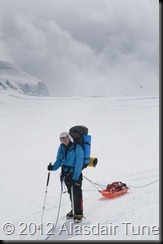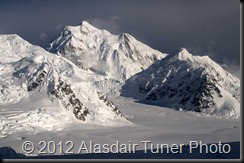I just got back from an early season trip on Denali. The expedition was exceptionally cold and windy. There were a few day on which I was able to shoot some reasonable photos however.
Soon after arriving at camp 1 the weather changed. I have had periods of bad weather low down on the mountain, but never bad enough weather that we were not able to carry loads to our cache. This storm was a bit different however. Below is a video of Aili working on getting dinner ready.
Birds often get blown off course and into the range with storms. This unlucky tree sparrow spent his last few hours with us at camp.
Sastrugi snow after the storm.
The next day we cached at about 9700ft and moved our camp to 11,000ft the day after that in mostly good weather. A third day of good weather allowed us to retreive our cache at 9,700ft the following day.
The following day was fairly good weather but a little windy. We decided to cache around windy corner this day followed by a move to the 14,000ft camp the next day.
The move to 14,000ft is a difficult day, so we took a rest day in good weather the day after.
The following day of good weather allowed us to retrieve our cache 600ft below camp.
 |
| Chris |
 |
| Zlatko |
 |
| Returning from our cache. |
 |
| Climbers returning to the 14,000ft camp. |
After a rest day at 14,000ft we decided to carry food and fuel up to the top of the fixed lines at 16,200ft. When we woke up that morning we could all see that the weather was changing fast. I was very worried about getting separated from our food and fuel so I chose not to make the carry, and instead spend the morning fortifying our camp. We also took this chance to send Lorenzo down with Chad due to altitude issues.
 |
| A lenticular cloud over the summit of Denali. |
 |
| Lorenzo heading down. |
Sergey and Vitali spent at least part of the day building an igloo.
 |
| Sergey and Vitali building an igloo. |
 |
| The master builder at work. |
By the middle of the day the weather started to worsen and by night the winds became very strong. We spent five days hunkered down at the 14,000ft camp due to very cold temperatures and high winds. This amount of time in one place on the mountain is pretty trying, but we managed to entertain ourselves by listening to NPR, an making some videos of both the weather outside, and our attempts to cook appetizing meals for ten without the use of our cook tent.
A short break in the storm allowed us to get outside and do a little digging and maintenance
Cooking for ten...
 |
| Mt Foraker after the storm. |
After spending way too much time in our tents we made the desision to decend rather than attempt a fast trip to the summit. I was concerned about the possibility of getting stuck in bad weather at 17,000ft camp after the ascent as the weather window to summit looked to be very short.






















































































































































































































